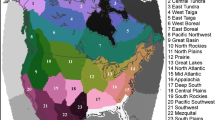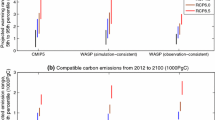Abstract
We consider the problem of projecting future climate from ensembles of regional climate model (RCM) simulations using results from the North American Regional Climate Change Assessment Program (NARCCAP). To this end, we develop a hierarchical Bayesian space-time model that quantifies the discrepancies between different members of an ensemble of RCMs corresponding to present day conditions, and observational records. Discrepancies are then propagated into the future to obtain high resolution blended projections of 21st century climate. In addition to blended projections, the proposed method provides location-dependent comparisons between the different simulations by estimating the different modes of spatial variability, and using the climate model-specific coefficients of the spatial factors for comparisons. The approach has the flexibility to provide projections at customizable scales of potential interest to stakeholders while accounting for the uncertainties associated with projections at these scales based on a comprehensive statistical framework. We demonstrate the methodology with simulations from the Weather Research & Forecasting regional model (WRF) using three different boundary conditions. We use simulations for two time periods: current climate conditions, covering 1971 to 2000, and future climate conditions under the Special Report on Emissions Scenarios (SRES) A2 emissions scenario, covering 2041 to 2070. We investigate and project yearly mean summer and winter temperatures for a domain in the South West of the United States.







Similar content being viewed by others
References
Banerjee S, Gelfand AE, Finley AO, Sang H (2008) Gaussian predictive process models for large spatial data sets. J R Stat Soc B 70:825–848
Beltrán F, Sansó B, Lemos R, Mendelssohn R (2012) Joint projections of north pacific sea surface temperature from different global climate models. Environmetrics 23:451–465. doi:10.1002/env.2150
Berliner LM, Kim Y (2008) Bayesian design and analysis for Superensemble-Based climate forecasting. J Clim 21(9):1891–1910. doi:10.1175/2007JCLI1619.1
Berliner LM, Millif R, Wikle C (2003) Bayesian hierarchical modeling of air-sea interactions. J Geophys Res Oceans. doi:10.1029/2002JC001413
Buser CM, Künsch HR, Lüthi D, Wild M, Schär C (2009) Bayesian multi-model projection of climate: bias assumptions and interannual variability. Clim Dyn 33(6):849–868. doi:10.1007/s00382-009-0588-6
Chandler RE (2013) Exploiting strength, discounting weakness: combining information from multiple climate simulators. Philos Trans R Soc London A Math Phys Eng Sci 371(1991). doi:10.1098/rsta.2012.0388. http://rsta.royalsocietypublishing.org/content/371/1991/20120388
Cressie N, Wikle CK (2011) Statistics for Spatio-Temporal data. Wiley, Hoboken
Finley A, Banerjee S, Gelfand A (2015) Spbayes for large univariate and multivariate point-referenced spatio-temporal data models. J Stat Softw 63:1–28
Furrer R, Sain SR, Nychka DW, Meehl GA (2007) Multivariate Bayesian analysis of atmosphere-ocean general circulation models. Environ Ecol Stat 14(3):249–266. doi:10.1007/s10651-007-0018-z
Gamerman D, Lopes HF (2006) Markov chain Monte Carlo - stochastic simulation for Bayesian inference, 2nd edn. Chapman and Hall, London
Giorgi F, Jones C, Asrar G (2009) Addressing climate information needs at the regional level: the CORDEX framework. WMO Bull 58:175–183
Giorgi F, Mearns LO (2002) Calculation of average, uncertainty range, and reliability of regional climate changes from AOGCM simulations via the “Reliability Ensemble Averaging (REA)” method. J Clim 15:1141–1158
Hannachi A, Jolliffe IT, Stephenson DB (2007) Empirical orthogonal functions and related techniques in atmospheric science: a review. Int J Climatolo 27:1119–1152
Harris GR, Sexton DMH, Booth BBB, Collins M, Murphy JM (2013) Probabilistic projections of transient climate change. Clim Dyn 40(11):2937–2972. doi:10.1007/s00382-012-1647-y
Kanamitsu M, Ebisuzaki W, Woollen J, Yang SK, Hnilo JJ, Fiorino M, Potter GL (2002) “NCEP-DOE AMIP-II” reanalysis. Bull Am Meteorol Soc 83:1631–1643
Mearns L, Gutowski W, Jones R, Leung L, McGinnis S, Nunes A, Qian Y (2009) A regional climate change assessment program for North America. EOS 90:311–312
Mearns L, Sain S, Leung L, Bukovsky M, McGinnis S, Biner S, Caya D, Arritt R, Gutowski W, Takle E, Snyder M, Jones R, Nunes A, Tucker S, Herzmann D, McDaniel L, Sloan L (2013) Climate change projections of the North American Regional Climate Change Assessment Program (NARCCAP). Clim Chang 120(4):965–975. doi:10.1007/s10584-013-0831-3
Meehl G, Covey C, Delworth T, Latif M, McAvaney B, Mitchell J, Stouffer R, Taylor K (2007) The WCRP CMIP3 multimodel dataset: a new era in climate change research. Bull Am Meteorol Soc 88:1383–1394
Rougier J, Goldstein M, House L (2013) Second-order exchangeability analysis for multi-model ensembles. J Am Stat Assoc 108:852–863. doi:10.1080/01621459.2013.802963
Salazar E, Sansó B, Finley A, Hammerling D, Steinsland I, Wang X, Delamater P (2011) Comparing and blending regional climate model predictions for the american southwest. J Agric Biol Environ Stat 16:586–605. doi:10.1007/s13253-011-0074-6
Sexton DMH, Murphy JM, Collins M, Webb MJ (2011) Multivariate probabilistic projections using imperfect climate models part i: outline of methodology. Clim Dyn 38(11):2513–2542. doi:10.1007/s00382-011-1208-9
Smith R, Tebaldi C, Nychka D, Mearns L (2009) Bayesian modeling of uncertainty in ensembles of climate models. J Am Stat Assoc:97–116
Stephenson DB, Collins M, Rougier JC, Chandler RE (2012) Statistical problems in the probabilistic prediction of climate change. Environmetrics 23:364–372. doi:10.1002/env.2153
Taylor K, Stouffer R, Meehl G (2012) An overview of CMIP5 and the experiment design. Bull Am Meteorol Soc 93:485–498
Tebaldi C, Arblaster J, Knutti R (2011) Mapping model agreement on future climate projections. Geophys Res Lett 38:L2371. doi:10.1029/2011GL049863
Tebaldi C, Sansó B (2009) Joint projections of temperature and precipitation change from multiple climate models: a hierarchical bayes approach. J R Stat Soc A 172:83–106
Acknowledgments
Dorit Hammerling had partial support from the NSF Research Network on Statistics in the Atmosphere and Ocean Sciences (STATMOS) through grant DMS-1106862. Bruno Sansó had partial support from grant DMS-1513076. We thank Anthony Tracy for his help with specifying the small sub regions. All the data used in this work is available upon request. Andrew Finley was supported by National Science Foundation (NSF) DMS-1513481, EF-1137309, EF-1241874, and EF-1253225, as well as NASA Carbon Monitoring System grants.
Disclaimer
Although Esther Salazar is a FDA/CTP employee, this work was not done as part her official duties. This publication/presentation reflects the views of the author and should not be construed to reflect the FDA/CTP’s views or policies.
Author information
Authors and Affiliations
Corresponding author
Electronic supplementary material
Below is the link to the electronic supplementary material.
Rights and permissions
About this article
Cite this article
Salazar, E., Hammerling, D., Wang, X. et al. Observation-based blended projections from ensembles of regional climate models. Climatic Change 138, 55–69 (2016). https://doi.org/10.1007/s10584-016-1722-1
Received:
Accepted:
Published:
Issue Date:
DOI: https://doi.org/10.1007/s10584-016-1722-1




